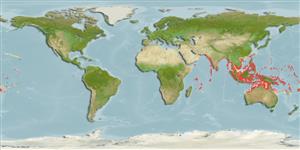Environment: milieu / climate zone / depth range / distribution range
Ecología
marino asociado a arrecife; rango de profundidad 0 - ? m. Tropical; 27°N - 23°S, 53°E - 157°W
Indo-Pacific: west coast of India and Sri Lanka (Ref. 6041) and from the Gulf of Thailand, Philippines, and East Indies eastward to New Guinea and western Polynesia.
Tamaño / Peso / Age
Maturity: Lm ? range ? - ? cm
Max length : 34.0 cm TL macho / no sexado; (Ref. 6041); peso máximo publicado: 176.00 g (Ref. 125281)
Espinas dorsales (total): 0; Radios blandos dorsales (total): 12-15; Espinas anales 0; Radios blandos anales: 10 - 13. Greatly prolonged, beak-like lower jaw; upper jaw short, triangular and without scales; preorbital ridge absent; total number of gill rakers on first gill arch 25-32; dorsal fin without well-developed anterior lobe; pectoral fins short, not reaching past nasal pit when folded forward; no vertical bars on sides (Ref. 9843).
Inhabits the immediate vicinity of coasts, but juveniles may sometimes be found with floating plants carried out to sea. Taken with purse seines at Karwar on the west coast of India and with dol nets at Bombay. Marketed fresh and dried salted (Ref. 9843).
Life cycle and mating behavior
Madurez | Reproducción | Puesta | Huevos | Fecundidad | Larva
Collette, B.B., 1984. Hemiramphidae. In W. Fischer and G. Bianchi (eds.) FAO species identification sheets for fishery purposes. Western Indian Ocean (Fishing Area 51), Volume 2. FAO, Rome. (Ref. 6041)
IUCN Red List Status (Ref. 130435)
Threat to humans
Harmless
Human uses
Pesquerías: comercial
Más información
Nombres comunesSinónimosMetabolismoDespredadoresEcotoxicologíaReproducciónMadurezPuestaAgregación para la puestaFecundidadHuevosEgg development
ReferenciasAcuiculturaPerfil de acuiculturaRazasGenéticaElectrophoresesheritabilidadEnfermedadesProcesamientoNutrientsMass conversion
ColaboradoresImágenesStamps, Coins Misc.SonidosCiguateraVelocidadTipo de nataciónSuperficie branquialOtolitosCerebrosVisión
Herramientas
Special reports
Download XML
Fuentes de Internet
Estimates based on models
Preferred temperature (Ref.
123201): 26.5 - 29.2, mean 28.3 °C (based on 1390 cells).
Phylogenetic diversity index (Ref.
82804): PD
50 = 0.5005 [Uniqueness, from 0.5 = low to 2.0 = high].
Bayesian length-weight: a=0.00380 (0.00214 - 0.00674), b=3.06 (2.91 - 3.21), in cm total length, based on LWR estimates for this species & Genus-body shape (Ref.
93245).
Nivel trófico (Ref.
69278): 3.4 ±0.47 se; based on food items.
Resiliencia (Ref.
120179): Alto, población duplicada en un tiempo mínimo inferior a 15 meses (Preliminary K or Fecundity.).
Fishing Vulnerability (Ref.
59153): Low vulnerability (24 of 100).
Nutrients (Ref.
124155): Calcium = 119 [44, 245] mg/100g; Iron = 0.702 [0.304, 1.869] mg/100g; Protein = 18 [15, 20] %; Omega3 = 0.106 [0.048, 0.307] g/100g; Selenium = 25.9 [12.5, 58.6] μg/100g; VitaminA = 80.1 [23.8, 327.6] μg/100g; Zinc = 1.36 [0.84, 2.10] mg/100g (wet weight);
